Art Tools of Aaron Gan
Today we have Singapore watercolour artist Aaron for this interview. He was previously a businessman and now a fulltime artist.
You can see his paintings at https://aarongan.com/ and https://www.facebook.com/aaron.gan.355
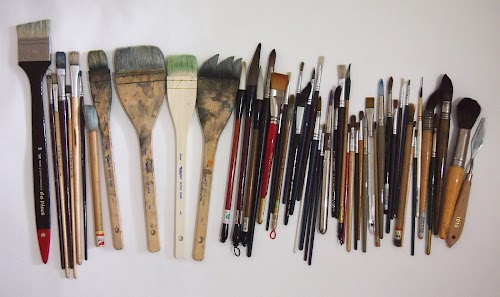

Qn: That's quite a huge collection of brushes. Let's go over them starting with the 5 above. What are the characteristics of these brushes? The brush hair for the 3 brushes on the right are quite interesting.
From left to right, I use the Escoda 6014 (no. 6) and Escoda Ultimo (no. 18) for painting large areas such as skies and putting in washes. The centre brush is Colorpro 2803 (no.5) which I used to use for skies but half the hair has dropped out since and I now use it only occasionally for painting foliage.
My main work brush is the Colorpro 2710 (no.10). It’s a mixed goat hair brush. The black one is a Colorpro 2250 (no. 8) red sable.
One thing to pay attention to is the ferrule of the brush you’re painting with. The bigger the ferrule, the more water (and paint) it can hold. For example, whenever I’m using the Escoda 6014 (the first brush) I need to make sure I load extra paint on the brush or the skies will fade to nothing when the painting dries.

Qn: These look like the smaller brushes. They seem to be in a series? What are they and what are they used for?
These are my brushes from Daiso (a $2 Japanese Store). You can buy a pack of 4-5 brushes for just $2. From left to right, the first group of brushes is used mainly for scrubbing (removing paint). I use the centre group for painting gouache and acrylic. The last group is used to paint unusual or uneven marks such as rocks or branches.

Qn: What are these two flat brushes? Is the handle of the top brush made of plastic? How does that handle differ from wooden handles?
The top brush is Colorpro 180 TSF (½”). The handle is made of plastic and the tip is pointed so that you can use it to scrap out marks (such as branches or fences etc). The red brush is Colorpro 2885 (1’’). I use this brush mainly to remove paint. I personally find it very hard to paint with flat brushes so these 2 are usually used to remove paint rather than apply paint.
I used to have a lot of trouble with scraping so I hope these few pointers will help:
- You can’t scrap if the paper is too wet.
- It is easier to scrap if the paint is thick.
- You can’t see the scrape line if you use a light color. I usually scrape in the dark areas.
- You can scrape with any round-edged objects. I use the scraper brush above, my fingernails and my old credit cards.

Qn: What are the characteristics of these brushes? They look like Chinese brushes, especially the ones on the right.
These are my fun brushes. They are an assortment of Chinese brushes and brushes from children sets.
I use them to make unusual marks or lines such as rocks, tree trunks, branches etc. Sometimes they are used to splatter paint. I also use them to paint water because they produce unpredictable lines, which is the essence of water.
I’ve also used them to add to speckles to the beach or to paint the stars in the skies.

Qn: And what are these 3 round brushes?
These are Escoda Perla Z series. They are my “pointed” brushes. I use them when I want my paintings to have sharp points. Given a same painting, simply using a different brush will give it a different feeling.
I find painting with a pointed brush gives it a more “realism” feel (see Quietude below). While painting with a round brush gives it a more “painterly” feel (See Pomegranates below)
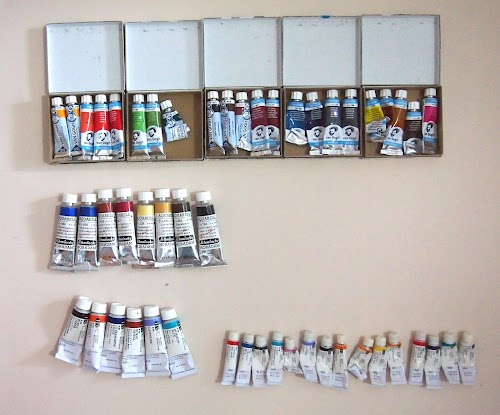
Qn: What watercolour paints do you use? I see several brands that you're using. Which brands do you prefer?
The top row is VanGogh. The second row is Schmincke. And the third row is Holbein.
I also use the occasional tubes of Winston & Newton (which are not in the photo because I’ve used up the tubes and haven’t bought new ones yet)
I like these brands because they are established brands with high pigment content and good range of colours.
Keep in mind that the names of the colours are only a guide. A Cobalt blue from Schmincke is different from a cobalt blue from Holbein.
Qn: I notice that those brands that you're using. They aren't sold in Singapore as far as I know. Where do you buy them from?
95% of my art materials (brushes, paints and paper) are bought from Straits Art (in Singapore). I make it a habit to buy something from there every time one of my painting is sold as a treat to myself.
Qn: What are your favourite colours?
Yellow Ochre, Lemon Yellow, Burnt Umber, Ultramarine Blue, Cobalt Blue, Ceruleun Blue, Paynes Grey
I particularly like Yellow Ochre and Cerulean Blue because they’re opaque and extremely hard to use. There’s a much higher than usual chance that they will mess up your painting because they will simply overpower all the other colours and they get “muddy” easily. (I learnt this the hard way-I have torn up my fair share of unsuccessful paintings)
The difficulty of use keeps me on my toes and prevents me from overpainting.
Qn: What type of watercolour paper do you use? The piece on the easel in the picture above looks huge. Where did you get it from?
I paint mainly on Saunders (Rough) and Fabiano (Rough). I buy them in packets of 10 “Imperial size” pieces. The piece on the easel is “Imperial size”, meaning it is 22x30”. For big commission pieces, I use Arches Rough (because it comes in a roll and the dimension is bigger). I use Schut occasionally but the paper is not easy to handle. I do not soak, stretch or prep my paper in any way before painting. I just take them out of the packet and start painting.
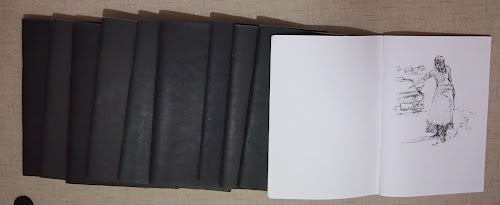
Qn: What sketchbooks do you use? What do you use them for? These do not look like they are suited for watercolour.
These are NOT for watercolours. They’re just normal sketchbooks that I get from Popular (a Bookstore chain in Singapore). I do mainly ink drawings and sketches in them. I try to get interesting compositions and ideas that can translate into a watercolour painting. I draw with a Staedtler pigment liner 0.8 for line drawings. For tonal sketches, I use a 2B lead mechanical pencil.
Qn: Who else do you think we should feature next?
Mr Chan Chang How. One of Singapore’s top watercolour artists.
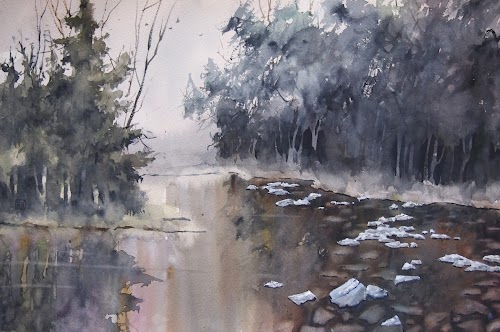
Quietude, 38x56cm
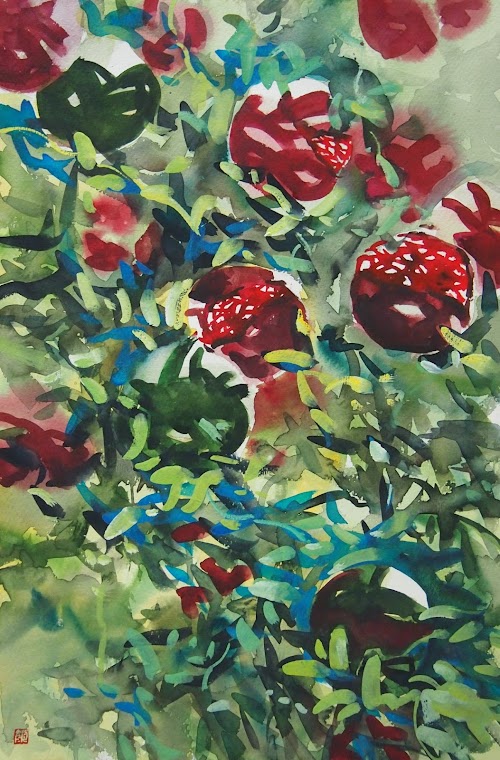
Pomegranates, 33x52cm
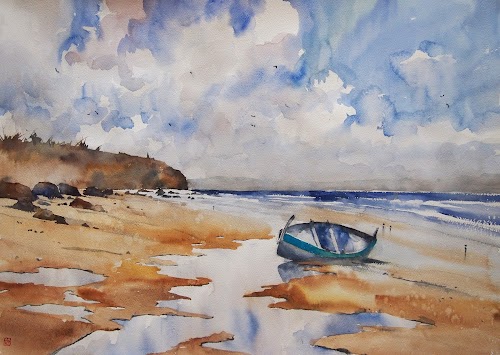
Less is more, 56x76cm
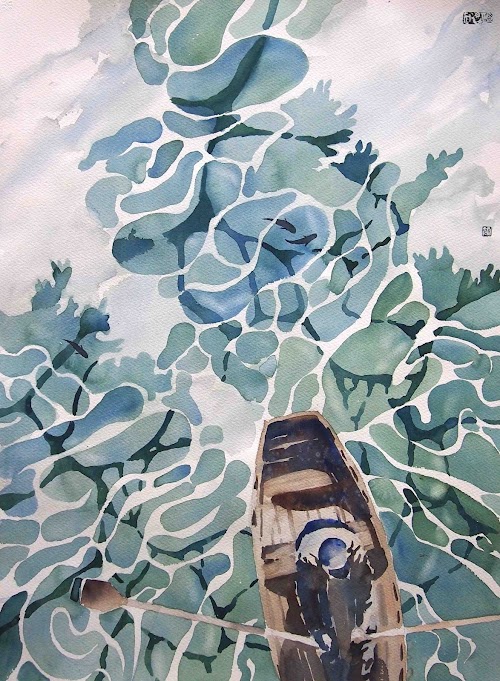
Rowing ashore, 56x76cm
Thanks. That's all from Aaron Gan.
You can see more of his artworks at
https://aarongan.com
https://www.facebook.com/aaron.gan.355
Items mentioned may be available at Dick Blick Art Materials, Amazon.com and Amazon.co.uk


